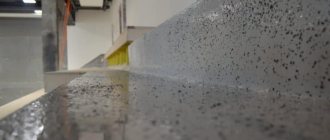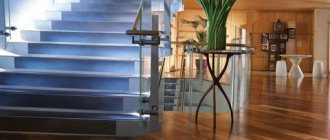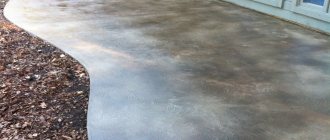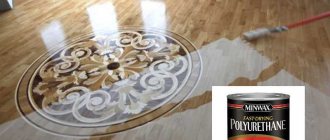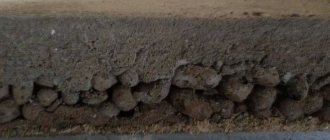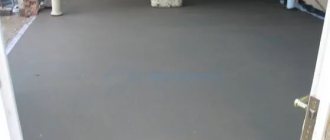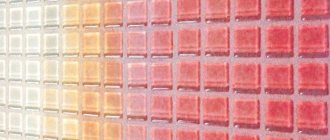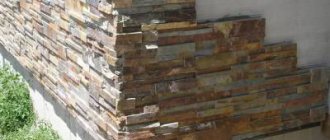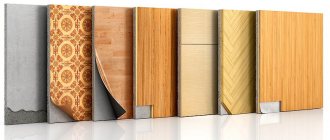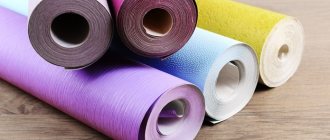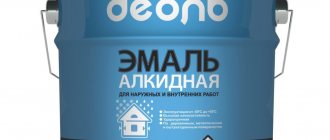Purpose and functions of screeds
Screed is a leveling layer of the floor that bears operational loads.
The screed performs a number of functions:
Makes the floor surface smooth.- Allows you to distribute the load of the floor over the entire area.
- Gives structures strength.
- Helps hide communications and the “warm floor” system.
- Prevents heat loss.
Increases the sound insulation of the apartment. It dampens noise and loud sounds.- Creates a surface slope.
- Raises the floor level.
Screed is a technological process that helps to achieve a perfectly flat surface for finishing.
Recommendations
We can recommend following the following basic rules for installing screeds using the mechanized method:
- to reduce the risk of cracks, use polypropylene fiber in semi-dry mixtures;
- wet the screed after installation for about 3-5 days;
The screed should be wetted for 3-5 days after installation. - Make sure that there are as few drafts and high temperatures in the room as possible - this way the moisture will evaporate much faster and cracks may form;
- at sub-zero temperatures in winter, do not allow the top layer of the screed to freeze;
- Sand only after the pressure mark is no deeper than 1 mm.
Following these simple recommendations will help you achieve better results.
It is better if there are no drafts in the room where the semi-dry floor screed was carried out
Main types of screeds
There are 4 types of screeds:
- dry;
- semi-dry;
- wet;
- bulk.
Wet screed
There are 4 types of wet screed:
The most popular is knitted. This option involves screeding the slabs.- Installation of screed on the waterproofing layer. It is usually performed in rooms with high humidity or the likelihood of water spills in them (bathroom, toilet, kitchen).
Wet screed using thermal insulation material. It is installed on the ground or on the ground floor of an apartment building. Such a screed is necessary to insulate the house and prevent heat leakage into the basement.- Wet screed ending with a self-leveling coating. This type of screed is used for flooring that is too susceptible to defects: laminate, linoleum, quartz vinyl tiles.
After installing the wet screed, a self-leveling mixture is poured, which can correct all unevenness and defects.
Dry screed
As the name suggests, all components of the screed do not contain liquid..
It consists of two parts:
Backfill part - which not only levels the base, but also creates a heat and sound insulating layer;
Solid sheet covering - this can be plywood, gypsum particle board (GSP), plasterboard sheet (GKL), particle board (chipboard), gypsum fiber board (GVP). They are laid on top of the backfill layer.
Bulk materials for dry screed
Expanded clay or crumbs made from it is foamed clay heated to a high temperature. Expanded clay is weightless due to its low density. It has the best thermal insulation properties.
Foamed vermiculite - this material is very light.
Expanded perlite is made by heating it to high temperatures (1000 degrees). Thanks to the manufacturing process, the water from the volcanic material is completely evaporated. It becomes so light that it can be blown away by the slightest movement of air. Therefore, when installing a dry screed with this bulk material, the windows must be closed.
Self-leveling floors
A type of floor screed that uses self-leveling mixtures is called a self-leveling floor. Its minimum thickness is 3.5 mm. Previously, such coatings were used for industrial buildings, but now they are used in houses and apartments.
The dry mixture is diluted with water according to the instructions to obtain the required consistency. The self-leveling mixture, poured onto the floor, occupies recesses and pits and removes surface defects. When using this mixture, you need to help distribute it over the floor using a spatula, removing air bubbles from it with a needle roller.
Application area
Mechanized screed has found wide application in the construction of multi-storey buildings for residential, commercial and industrial purposes. First of all, this is due to the fact that the preparation of the mortar takes place directly at the construction site and builders do not depend on interruptions in the supply of ready-made mortar from the concrete plant or the breakdown of a vehicle mixer along the way. It is enough to bring to the site the required amount of dry ingredients to prepare the mixture and have a certain amount of water. Also, all work on arranging the subfloor can be carried out even in houses with no power supply due to the fact that the equipment for such work is available with both electric drive and diesel engines (which contributes to an uninterrupted and continuous process of work). Construction time is reduced, since less time is needed for the final drying of a semi-dry screed constructed in this way.
This method is also becoming increasingly popular in individual construction. Some companies specializing in the installation of such screeds are ready to accept orders for work in rooms with a small area (from 40÷50 m²). The treated surface will be ready for laying any finishing floor covering in 8-10 days. Although it must be borne in mind that financial costs will be greater than with traditional methods.
Advantages and disadvantages of mechanized floor screed
The most popular type of screed is a semi-dry mechanized screed.
Mechanized screed has a number of advantages:
This screed method creates a perfectly flat surface on which any floor covering, even the most capricious, can be laid. Re-leveling is not required, because the floor screed is mechanized using trowelling machines.- For mechanized screed, a solution is prepared to which little water is added. That's why it hardens quickly. After 12 hours it can already withstand the weight of the human body, and after 94 hours construction work can begin.
With this type of screed, fiber fiber is added to make the solution better quality. Fiber fiber helps make the base more durable, prevents microcracks and reduces the final mass of the screed. This option is suitable for houses with weak foundations. Fiber fiber increases the durability of the screed and its abrasion resistance. It is a fibrous structure similar to cotton wool. Fiber fiber is inexpensive. It is necessary to add it to the working mixture.
The availability of mechanized screed lies in the fact that the materials for the concrete mixture are everywhere: sand, cement, fiberglass. Their cost is small.- The mortar for mechanized screed is mixed quickly at the site where construction work is being carried out. The mortar is prepared outside, so there will be no dust and dirt from cement and sand in the room, or splashes from the mortar on the walls.
- High execution speed is an important advantage of mechanized screeding. In 1 day, a team of builders
can apply a screed covering an area of 250 square meters to the floor. With the manual method and wet screed it will take 5-7 days. - Automation of the screed reduces the labor intensity of the work. Kneading, transportation and surface leveling are carried out using machines.
- No leaks to the lower floors. Since little water is added to the solution, the risk of leakage onto neighbors is minimal.
The disadvantages of machine screed include:
Use of expensive equipment. The technology for leveling the base is such that it is impossible to do without special equipment.- If the room is small, then using a mechanized screed is unprofitable. Buying or renting specialized equipment for laying screed and carrying out one-time work in a small area is an expensive pleasure.
- It is unlikely that you will be able to perform the screed using technology yourself, because there is no experience in handling it. Therefore, calling a specialist is necessary.
- Not all construction organizations accept orders for mechanized screeding. They do not service apartments smaller than 100 square meters. Therefore, you need to negotiate with your neighbors about carrying out joint work, and this is very difficult.
- The cost of mechanized screeding is high because special equipment is required.
Minuses
In addition to the obvious advantages, the use of this type of screed also has some disadvantages.
Firstly, the mechanisms used during installation are quite expensive - you cannot purchase them yourself and do the screed yourself. In any case, you will have to contact the company that deals with this. Also, performing the work requires serious professional experience - you won’t be able to save money by doing the work yourself.
The disadvantage of this option is that you won’t be able to do everything yourself - the equipment for semi-dry screeding is very expensive
It also follows from this point that most organizations performing such work only undertake premises with a large area - the minimum order will be at least 100-500 square meters. Most likely, you will have to try hard to find specialists who will take on the work in a small apartment. It may be advisable to place a joint order with your neighbors to complete screeding in several apartments at once. This will be especially relevant for residents of new buildings who are actively moving in immediately after construction is completed.
Secondly, this is not a budget option at all - the use of modern equipment, its repair and operation must pay for itself. Therefore, the cost will be several times higher than with manual screeding.
This option is quite expensive, although of high quality.
Use and equipment for mechanized screeding
Mechanized screed is used when the base surface will become a finishing coating - in garages or warehouses.- This type of screed is also used when the floor covering: linoleum, laminate requires a perfectly flat surface so that there are no flaws. This is much easier to do mechanically. Labor-intensive processes: mixing the solution,
It is transported to the floors and polished by machines. - A machine screed is also needed when you need to make the floor rigid, durable, and install an additional layer of sound insulation.
- A mechanized semi-dry screed is created when it is necessary to hide a water-heated floor system or electric floors.
The following equipment is used for machine screeding:
Pneumatic compressor. This is a multifunctional machine that acts as a pump and mixer. She quickly and thoroughly mixes the working mixture. The pneumatic compressor transports the composition through hoses using high pressure, which facilitates the work of builders. They don't have to carry heavy bags of mixture up to the floors. The design of pneumatic blowers includes a tank for mixing the solution, a supply system, a drive and a concrete pipeline. Pneumatic compressors of the German brands “Putzmeister” and “Brinkmann” are mobile. They move around the construction site on their own chassis. The solution tank holds 640 liters of mixture. The equipment is productive. It quickly supplies the solution to the house: 5 cubic meters per hour.
Quencher. This machine allows you to minimize high pressure, and the solution comes out of it in an even layer, without shock. The device provides high stability when supplying the solution to the house.
A laser level will help you establish its level and place the beacons correctly. The Bosch GRL 250 HV device will allow you to check whether the screed is correctly aligned. Rotary laser levels have a small error. Lasers are famous from
Troweling machine – grinds the screed in such a way that it removes all its unevenness and small voids. It also compacts the surface.
Trowel - helps to level the surface in hard-to-reach places that a trowel could not cope with. The length of the instrument is half a meter. It has a comfortable handle.
Metal ridge - used for cutting expansion joints. The tool is made of aluminum, 280mm long, 120mm wide. Wooden handle. A tool like this helps prevent damage to the subfloor if the materials expand.
Rules – the “Sola” rule is especially appreciated. It helps to level the cement-sand mixture between the beacons. The absence of burrs on it makes it safe and saves you from injury. The presence of shock-absorbing caps protects the surface from scratches and abrasions. The luminous background makes it possible to see the indicators of the tool, which will help level the floor without errors.
Fiber screed
As in the case described above, it is necessary to add such an amount of water to the mixture so that the cement can be fully saturated with it and there is enough liquid for impregnation. It is the fact that a small amount of water is required that gives advantages to this type of screed, it also increases the strength of the coating and minimizes shrinkage and cracking.
Typically, fine sea sand, as well as cement in accordance with GOST M500, are used to prepare a mortar for screed with the addition of fiberglass. Additionally, to make the material stronger, a plasticizer is added - it will also allow the solution to be much more elastic, and the addition of reinforcing fiber fiber makes the solution stronger and prevents the formation of cracks and other defects.
Features of fiber fiber
Fiber screed care
You can regularly wet the screed with a small amount of water if it is not possible to use polyethylene. 10-12 hours after installation work, you can already walk on the screed, and after 4 days you can begin laying the final version of the coating.
Fiber fiber has many advantages when compared with ordinary traditional materials, such as reinforcing mesh. Propylene fiber is added - this makes it possible to almost completely avoid the appearance of cracks, the service life becomes longer, and the surface has a neat and attractive appearance.
Fiber fiber allows you to avoid the appearance of cracks, due to which the life of the floor increases significantly
By the way, many foreign standards recommend the use of propylene fiber, and not the previously traditionally used reinforced mesh.
Important! This is due to the fact that over the course of operation, the mesh usually significantly loses its characteristics, while the fiber holds up much better.
When installing fiberglass screed, be sure to pay attention to the presence of sub-zero temperatures in the room - the solution must not be allowed to freeze, therefore, if work is carried out in winter, it is necessary to add specialized anti-freeze additives to the mixture. Also note that the initially inert components of sand-cement screed, when mixed with water, can be aggressive towards some metals such as aluminum.
Do not carry out work in a room where the temperature is below 5 degrees Celsius
Semi-dry fiberglass screed is in most cases just the base, but not the final finishing layer. Other materials are subsequently laid on it.
Mechanical screed technology
The execution of the screed goes through several stages.
Preparing the base
The base is swept and debris removed. If there are cracks, then putty. The base is treated with a primer.
For sound insulation and waterproofing, a 100-micron thick polyethylene film or a 5-10 mm thick polyethylene foam backing is laid. A damper tape is glued along the perimeter of the walls 3-5 cm above the level of the future screed to compensate for internal stress. After the screed has hardened, the excess damper tape is cut off.
Setting the screed level.
Using a laser level, mark the highest point of the floor and draw a horizontal line.
This is the zero floor level. The thickness of the future screed is set off from it and its level is noted. The thickness of the future screed is calculated.
Preparing the mixture
The working mixture is prepared in a pneumatic supercharger. First, sand is poured, then fiberglass and cement are placed. Lastly, water with a plasticizer introduced into it is poured.
The solution is stirred in the air blower for 3 minutes. The work is carried out outdoors at a temperature not lower than -5 degrees. If it’s cold outside, then a “warmhouse” is built above the place where the solution is mixed.
Receiving the mixture
The mixture is transported to any floor using a pneumatic blower. Compressed air drives the solution through the sleeves - transport hoses. The solution is received in a special absorber connected to a transport hose. It relieves high blood pressure. The mixture is supplied horizontally to a distance of up to 200 meters, and vertically to 80 meters.
Distributing a mixture using a rule
The room temperature should be no lower than +5 degrees. As soon as we have unloaded the semi-dry mixture onto the base, beacons are marked using a laser. Two beacons are installed on opposite walls. If the room is large, then several more beacons are planned between them. The distance between the beacons should be 20cm less than the length of the rule. The working mixture is poured into the space between the beacons, which is then leveled using the rule. The length is usually one and a half to three meters. The rule levels the working surface.
Grouting the screed with a disc grinder
To ensure the surface is perfectly smooth, turn on the grinder and rub the screed with a disc. She also polishes the surface, removing pits and bumps. Machine smoothing and sanding should begin within two hours after mixing the working mixture to prevent it from sticking. When working with a disc grinder, builders wear concrete shoes, because without them, after grinding the screed, you cannot walk on it.
Installation of expansion joints
Carried out in accordance with project documentation. If they are not noted in the design documentation, then expansion joints are cut at doorways, at junctions with protrusions, niches, columns, and in areas with height differences. If the room is large, then the floor area is divided into expansion joints (squares or rectangles) every 15-20 square meters. Expansion joints are necessary to prevent the formation of microcracks during the drying process of the screed.
Caring for hardening screed
After installing the screed, it should be covered with plastic wrap for one or two days so that it hardens evenly, especially if there are drafts, dry air or penetrating bright sunlight in the room.
If the temperature in the apartment is high, then before covering it with film you need to moisten the surface of the screed. After two days, the film must be removed.
And after a few more days you can lay the flooring. But if you are in no hurry, then it is better to wait 28 days, because this is the optimal period for its ripening.
Price of mechanized semi-dry floor screed
Let's compare the prices of semi-dry screed in different cities of our country:
The price of mechanized floor screed in Moscow and St. Petersburg is from 450 rubles per square meter, and machine plastering of walls is 540 rubles per m2,- In Mytishchi - 423 rubles per m2.
- In Saratov, the price for work ranges from 400 to 600 rubles per square meter.
- In Samara, for work on mechanized screed using German technology, you will pay 360 rubles per square meter.
- The price per square meter in Dmitrov varies from 470 rubles to 900, depending on the thickness of the screed and the area.
Prices are given for a turnkey screed, labor and materials are included in the price.
A mechanized screed makes it possible to quickly and without much labor make the floor even and smooth. Any floor covering will look chic and beautiful on such a screed.
What equipment will you need?
Let's take a closer look at exactly what equipment is needed to perform a mechanized screed.
First of all, you will need a pneumatic supercharger. You can’t do without it - this device combines the functionality of a kind of concrete mixer and pump. All the ingredients that make up the mixture are mixed in a container, and then under pressure this mixture is supplied to the surface on which the screed will be laid. Moreover, the power is quite high - the solution can be transported over a distance of up to two hundred meters, and also raised to the height of an almost 34-story building (that is, up to 120 meters).
You will also need a vibrating screed. It is used as a rule that is used for manual screeding. Using this tool, the finished laid mortar is leveled, as well as the mass is compacted.
For mechanized floor screeding, a pneumatic blower, vibratory screed, and grinder are required
Grinding machine - used to ensure that the screed is properly compacted, and also removes voids and rubs the surface.
A jointer (joint cutter) is a tool for cutting expansion joints. If a significant enough area is being poured, this will be necessary to prevent damage.
What is a pneumatic supercharger
What are the possible disadvantages of using a semi-dry screed?
Floor screed is necessary in order to perform a high-quality and even “rough” version of the floor for subsequent laying of any type of floor covering. It can be used in almost any conditions, in workshops, garage floors, apartments or houses. The most popular is semi-dry concrete screed, which is gaining more and more popularity in the construction industry every day.
Characteristics and properties
The technology of “wet” manual leveling involves organizing work in two stages. First, the load-bearing “rough” layer is poured, and after that the finishing fill of the self-leveling mixture is done. But this means additional financial losses for the purchase of materials and an increase in order fulfillment time. Mechanized floor screeding in cottages and apartments does not require extra costs and guarantees high quality workmanship.
Advantages of mechanized screed technology
Rice. 1. Mechanized screed in a private house.
- Fast setting
- semi-dry material contains only the amount of moisture that is needed for the cement hardening process. Therefore, drying of the laid composition takes much less time. Just 2-3 hours after grinding is completed, it becomes possible to move on the surface in special shoes, and you will be able to walk in simple shoes after a day. - Low order fulfillment times
— a high level of mechanization and the absence of forced technological breaks during the process can significantly increase labor productivity. So a team of 4 people can lay up to 200 m2
leveling coating in one work shift. This means that mechanized floor screeding in an apartment with 3-4 rooms will be completed in 1 day, while manual installation takes at least 4 days.
- Complete absence of shrinkage
- active evaporation of moisture from the “wet” mixture leads to the appearance of shrinkage processes, changes in the geometry of the layer and the possible formation of cracks. This happens especially often with increasing thickness. In a semi-dry composition there is little water and the risk of defects is minimal. In addition, the likelihood of cracking is limited by the addition of polypropylene reinforcing fibers. - No additional finishing work is required
- to obtain a perfectly flat surface, the laid material is processed in the final part with a special grinding and troweling machine. Grinding is carried out until the cement has completely set, while the composition is still wet. After grinding, the mechanized screed allows a possible horizontal plane error of no more than 2 mm per 3 meters of length. In addition to leveling, this process additionally compresses the layer, increasing its strength and durability. - Liquid does not leak into the voids of the ceilings
- the amount of water in the semi-dry composition is so small that it all enters into a chemical reaction with the cement and there is simply no liquid left for leaks. Therefore, the likelihood of unpleasant disputes with neighbors is completely excluded. - There is no pollution or dust
- the preparation of the working composition takes place outside, and it is supplied through a long high-pressure rubber hose. Therefore, there is no cement dust, sand or splashes on the walls indoors. The semi-dry mixture is laid neatly without spilling.
Disadvantages of mechanical screed
Despite the large number of advantages, it also has its disadvantages. Among them, experts include:
- low profitability with a total floor area of less than 80 m
2;
- the use of complex, expensive mechanisms that require maintenance;
- higher cost of services compared to the manual “wet” method.
However, when considering the price issue, it is necessary to take into account the lack of costs for the final leveling layer when mechanizing the work, which makes the costs for the two technologies quite comparable.
As you can see, the advantages of a mechanized screed significantly outweigh the number of disadvantages.
Components and types of additives
Rice.
2. Basic materials for mechanized screed To prepare ordinary cement mortar you need:
- cement;
- washed or river sand;
- plasticizer;
- pure water.
In order to improve the physical, mechanical and operational properties, polypropylene fibers, granite chips, expanded clay and polystyrene granules can be added to the mixture.
The accepted average layer height is in the range of 50-60 mm. This makes it possible to conceal the installation of utility lines in the thickness of the floor. If there is no such need, then the thickness can be reduced. It should be remembered that the minimum permissible size of a mechanized screed is 30 mm.
Polypropylene fiber fiber
The presence of strong polymer fibers in the cement mortar increases the elasticity of the material and effectively reinforces the leveling layer after setting. Therefore, laying a metal mesh in this case is not required. In addition, the presence of this additive helps to reduce the hardening time of cement.
Crushed granite
The addition of fine granite chips increases the strength and wear resistance of semi-dry mechanized screed. Such mixtures, in combination with polymer fibers, are often used to construct floors in retail facilities, warehouses and in production workshops of industrial enterprises, where there are significant operational loads on the surface.
Expanded clay
Expanded clay granules belong to the category of thermal insulation materials. Therefore, their presence in the composition will reduce heat losses and be able to dampen sound vibrations. The weight of the cement layer in the presence of expanded clay will become less and this can be used if it is necessary to increase the thickness of the coating or its installation over a thin and weak ceiling.
Polystyrene granules
Polystyrene concrete is moisture resistant, has a low thermal conductivity coefficient and good sound insulation qualities. Mechanized floor screed with its addition is characterized by increased density, strength and elasticity. Polystyrene is able to protect metals from electrochemical corrosion and stray currents.
How does the process work?
In this video you can see how a semi-dry floor screed is performed using a mechanized method.
The work takes place in stages, each stage is carried out in a clear sequence.
Stages of performing a mechanized screed:
- surface preparation;
- preparing a mixture of sand, cement and additives;
- supply of the mixture and its distribution;
- Grouting the surface and removing dust.
Surface preparation involves removing debris, laying electrical wiring, and installing underfloor heating and heating systems.
Laying a waterproofing layer is necessary in order to protect the lower layers of the subfloor from absorbing moisture from the solution.
As such a layer, you can use ordinary polyethylene film or special materials for this purpose.
To prepare the solution, the following components are required:
- fiberglass;
- sea sand;
- modifier;
- Portland cement M500.
The grain size of sea sand should not exceed 0.5 cm.
Laying plywood on a wooden floor. How to lay plywood correctly, efficiently and quickly is described on our website.
If you don't already know, you should know that floor tiles can be laid over wood floors. Yes, yes, on wood! This article explains everything in detail!
Few people know how to lay laminate flooring with their own hands, but it is very easy to do. In this article you will find a lot of useful information. Happy renovation!
Polypropylene fiber is necessary to increase the strength of the floor; it is a reinforcing component.
The modifier increases the elasticity of semi-dry screed, its strength and ductility.
A pneumatic blower delivers the prepared cement-sand mortar to the installation site and distributes it over the entire base of the floor.
The required thickness is ensured using specially installed beacons.
A special smoothing machine ensures perfect leveling of the screed.
It compacts the top layer.
A special primer removes dust from the surface of the concrete floor.
